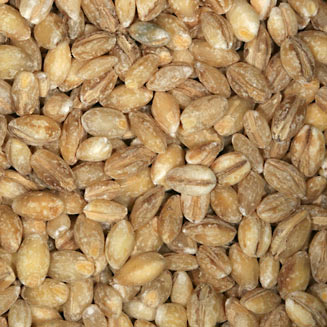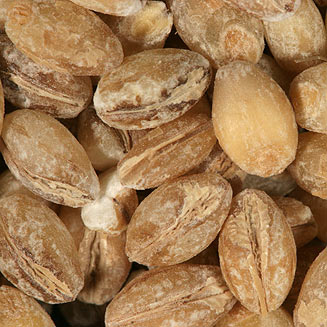Hordeum vulgare (Barley) gars [Afrikaans]Life
> eukaryotes >
Archaeoplastida >
Chloroplastida
>
Charophyta > Streptophytina > Plantae (land plants)
> Tracheophyta (vascular plants) > Euphyllophyta > Lignophyta (woody plants)
> Spermatophyta (seed plants) > Angiospermae (flowering
plants) > Monocotyledons > Order: Poales
> Family: Poaceae
 |
 |
|
Barley grains. [photo H. Robertson, Iziko
©] |
Domesticated more than 9750 years ago in the Near East.
It is a nutritious grain with nutrients concentrated mainly
near the bran - hence the more the grain is milled the less nutritious it
becomes. Barley absorbs the flavours of the liquid it is cooked in
and hence is a good addition to soups and stews. It can also be eaten with
vegetables as a vegetarian meal with a reasonably high protein content. It is
often used as a substitute for rice. The main use of barley in southern Africa is for malting
to produce beer.
Domestication
Together with wheat, Barley was one of the main cereals
that was domesticated in the Mediterranean and Near East regions during the Neolithic period. As far back as 17000 BC, people in the Near East were collecting seed
from wild wheat and barley, this early evidence stemming from seed remains found
at an archaeological site near the Sea of Galilee in Israel. The earliest record
of domesticated barley is 7750 BC, from an archaological site north of Jericho.
Compared with wheat, barley has the advantage of being able to withstand drier
conditions and less
fertile, fairly saline soils.
Domestication of barley involved changing a number of
properties of the plant: (1) there was selection for non-brittle varieties, i.e.
those in which seeds were retained on the plant and not shed before harvest.
Selection of such a property happened automatically because it was only the
retained seeds that were successfully harvested and used as seed for the next
planting; (2) wild and early crop varieties of barley had only two rows of
spikelets whereas in later cultivated forms there were six rows of spikelets;
and (3) most varieties of barley have hulled seeds, i.e. the husk of the seed is
tough and does not come off during the threshing process. However, there has
been selection in some varieties for free-threshing forms. Hulled varieties are
often preferred for brewing beer and for animal feed while those with naked
grains are favoured for direct consumption (Zohary & Hopf 1993).
Like most other grasses that have been domesticated, barley has
the advantage of being a self-pollinator.
Uses
Barley is often regarded unfoundedly as inferior food compared with
wheat but it is a nutritious grain and is a good source of phosphorus,
magnesium, iron, niacin and soluble fibre. The nutrients are concentrated mainly
near the bran and hence the more the grain is milled the less nutritious it
becomes.
Types of barley encountered in shops include the
following.
- Flaked barley. The grain is flattened, like
rolled oats.
- Pot barley or Scotch barley. Coarsely
ground with most of the husk (and hence nutrients) removed.
- Pearled barley. Outer husk and bran is milled
off in such a way as to produce pearl-like grains. Poor in nutrients because
of the loss of the bran layer but it takes less time to cook (about half an
hour). In Afrikaans, well-milled barley of this sort is termed kaalgars
(i.e. 'naked barley').
- Hulled barley. Only the outer husk is removed
and not the bran layer, hence most of the nutrients are retained. However,
being less refined it takes longer to cook (grain needs to be soaked in
water for a few hours and then boiled for about an hour).
- Barley flour. Barely grains ground into flour
that is dark coloured, not white. The low gluten content means that it does
not cause rising of baked goods and hence is usually mixed with other flours
when used in baking.
Barley absorbs the flavours of the liquid it is cooked in
and hence is a good addition to soups and stews. It can also be eaten with
vegetables as a vegetarian meal with a reasonably high protein content. It is
often used as a substitute for rice.
The main use of barley in southern Africa is for malting
to produce beer.
References
-
Anon. 2002. Encyclopedia of Foods. A Guide
to Healthy Nutrition. Academic Press, San Diego, California.
-
Harlan, J.R. 1995. The living fields - our
agricultural heritage. Cambridge University Press, Cambridge.
-
Sauer, J.D. 1993. Historical geography of
crop plants - a select roster. CRC Press, Boca Raton, Florida.
-
Zohary, D. & Hopf, M. 1993. Domestication
of plants in the old World - The origin and spread of cultivated plants in
West Asia, Europe, and the Nile Valley. Clarendon Press, Oxford.
|
